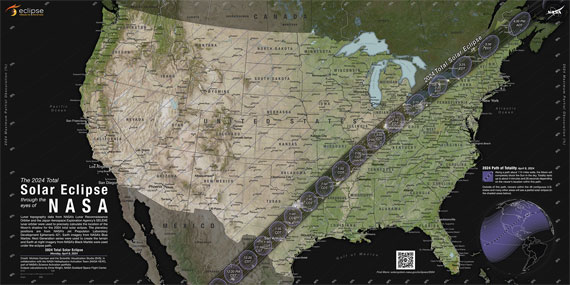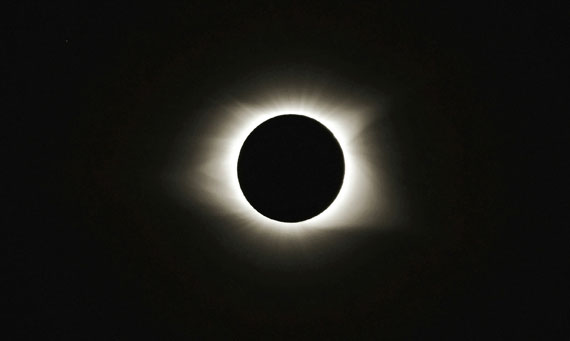The total solar eclipse of 2024 is an eagerly anticipated event for astronomers, enthusiasts, and photographers around the globe. Capturing this celestial phenomenon requires preparation, the right equipment, and a bit of know-how. Here’s your comprehensive guide to photographing the 2024 total solar eclipse.
On April 8, 2024, a total solar eclipse will cross North and Central America creating a path of totality.

Credit: NASA‘s Scientific Visualization Studio
The dark path across the map is where the largest area of the Sun will be covered by the Moon. People in this path will experience a total solar eclipse.
1. Understand the Phenomenon
Before you set out to photograph the eclipse, it’s crucial to understand what you’re about to witness. A total solar eclipse occurs when the moon passes between the Earth and the sun, completely blocking the sun’s light. This event unfolds in phases – partial eclipse, total eclipse, and then partial eclipse again.
2. Choose the Right Equipment
- Camera: A DSLR or a mirrorless camera with manual settings is ideal. You can also use a point-and-shoot camera with manual mode or even a smartphone with a good camera.
- Lens: A telephoto lens (200mm or longer) is recommended to capture detailed images of the eclipse.
- Tripod: A sturdy tripod is essential to stabilize your camera, especially during the longer exposures required for eclipse photography.
- Solar Filters: You must use a certified solar filter over your lens to protect your camera sensor (and your eyes) from the intense sunlight.
For more advanced gear & settings, check out LensRentals Eclipse Plan
3. Select Your Location
Scout for a location with a clear view of the sky. High elevation and minimal light pollution can contribute to a better photographic experience. Ensure your chosen spot is within the path of totality to capture the full effect of the eclipse.
4. Practice and Prepare
- Practice: Test your equipment and practice your settings in the days leading up to the eclipse. Familiarize yourself with your camera’s manual mode to adjust shutter speed, aperture, and ISO quickly.
- Prepare: Charge your batteries, clear your memory cards, and have all your equipment ready. Consider bringing backup equipment if possible.
5. Camera Settings
- Manual Mode: The dynamic range of the eclipse requires you to switch between settings rapidly. Start with a low ISO (100-400), a small aperture (around f/8 to f/16), and adjust the shutter speed according to the brightness.
- Focus: Use manual focus and set it to infinity. You can practice focusing on a distant object to ensure sharpness.
- Bracketing: Since the lighting conditions change rapidly, consider using exposure bracketing to capture a range of exposures.

Photo captured by Jan Haerer
6. During the Eclipse
- Partial Phases: Use your solar filter to photograph the phases leading up to and following totality. Change your settings as the light dims.
- Totality: This is the only time you can safely remove your solar filter to capture the corona’s exquisite details. Adjust your settings to capture the dimmer light – this might include increasing the ISO or using a longer shutter speed.
- Safety: Never look directly at the sun without proper eye protection, and ensure your camera’s viewfinder is not used to observe the sun unless you have a solar filter attached.
7. Share Your Experience
Eclipse photography is not just about the technical details; it’s also about sharing this rare celestial event’s awe and beauty. Share your images with the community, engage with other photographers, and discuss your experiences and techniques.
Photographing a total solar eclipse is a thrilling experience that combines the art of photography with the grandeur of the cosmos. With the right preparation and technique, you can capture stunning images that encapsulate the awe-inspiring beauty of this celestial event. Happy shooting, and here’s to hoping for clear skies in 2024!
For a cheat sheet you can print and take with you: Printable Photo Cheat Sheets
- - - - - - - - - - - - - - - - - - - - - - - - - - - - - - - - - - - - - - - - - - - - - - - - - - - - - - - - - - - - - - - - - - - - - - - - - -
This post How to Photograph a Total Solar Eclipse appeared on PictureCorrect.
from PictureCorrect https://ift.tt/rOYJU4y
via IFTTT






0 kommenttia:
Lähetä kommentti